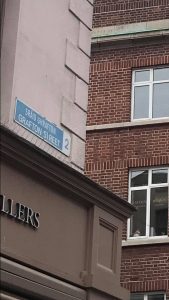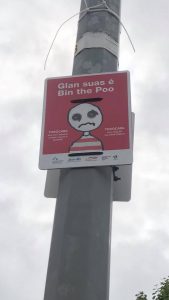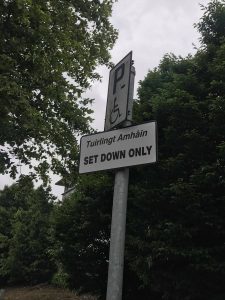After spending three weeks in Dublin, I have realized that the city is more modernized than I thought it would be. Rafael, Cenoz, and Gorter “found that English was used to signify modernity or cosmopolitanism” (Rafael et al., 2006 and Cenoz and Gorter, 2006 in Scollon, Scollon, and Jones, 2012). Although the Irish Gaelic language is still frequently used everywhere, most store names and signs are in English or have English translations. I also had not realize that Dublin was such a popular tourist destination in which there are many different people and languages used. As I further analyze the symbolic functions of Dublin’s languages, economies, and the overall linguistic landscape, I see its efforts to attract visitors from around the world, to preserve history, and to make the city more vibrant.
In terms of language, Dublin’s main two languages are Gaelic and English. The authors of the book ‘Intercultural Communication’ suggest that “the ratio of languages is indicative of the relative power of various ethnolinguistic groups” (Scollon, Scollon, and Jones, 2012). I think that the ratio of English and Gaelic is even, suggesting that the Irish and English people are relatively equal in power. However, I have noticed that the Gaelic language is always above the English translation on signs. This holds true for different communities, such in Grafton (left picture), one of the most popular tourist shopping streets in Dublin City Centre, and in Santry (right picture), a suburban neighborhood. Thus, although Dublin shows a multilingual community, it still wants to make tourists and residents aware that Gaelic was the first official language of Ireland.


As well, the English translation below the Gaelic seems like a direct word-for-word translation because we typically would not use the phrase “Set Down Only” in English to say that an area is a drop off only zone (see picture below). This suggests that the primary language of Ireland is Gaelic, and English is just an additional language to be able to communicate with foreigners.

Furthermore, by examining economies, I see what the book, ‘Intercultural Communication’, describes as commodification in the urban landscape. In Capel Street, the city uses symbols of Chinese culture to sell Asian commodities and to market Dublin using ethnic diversity (Modan, 2008 in Scollon, Scollon, and Jones, 2012). One of the Asian markets on Capel Street has Chinese letters in front of the store name, ‘Super Asia Foods’. These letters “[convey] distinction and a sense of authenticity” (Backhaus, 2007 in Scollon, Scollon, and Jones, 2012). I have also noticed more Asian people in this area because it attracts foreign visitors who have needs for familiarity in a unfamiliar city. This leads to ethnic diversity, which is an effective tool to market a city because it sends the message that all people are welcome.
Finally, with the overall linguistic landscape of Dublin, I have noticed that in Grafton Street, Santry, Capel Street, or any other area in Dublin, the speech that I hear on the street is different from the languages that are publicly written. Most everyone speaks in English, despite the Chinese, Gaelic, and other languages that are written on street signs. In addition, the book mentions that one of the criteria to categorize signs is the type of institution, such as public and private enterprises (Scollon, Scollon, and Jones, 2012). In Dublin, the signs posted by public and private enterprises are different. Public enterprises, such as museums and transportation, have multiple different languages available for translation purposes. For example, when I visited the National Museum of Ireland, it had guides printed in multiple languages. Whereas, private enterprises tend to have one main language, such as English in Primark, an Irish clothing and accessories company.

Hearing about your experience in Dublin seems to sound very similar to my experience in Hong Kong this summer. In Hong Kong we have a lot of signs that have both Chinese and English. However, I think the some of the English terminology that is used is influenced more by British English and would make sense it’s not American English. So Set Down Only is more of a British English term. In Hong Kong, they call the elevator lift and that makes sense cause they were colonized by the British.
I think it’s really interesting how the article correlates modernity with the prevalence of English. I wonder if English influence is what made Dublin become more commercialized. It’s also found it interesting how although English dominates the general linguistic landscape, Dublin’s government and it’s people still work towards preserving remnants of Gaelic culture in the city.